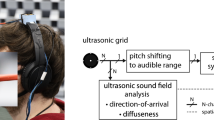Abstract
We have designed an auditory guidance system for the blind using ultrasonic-to-audio signal transformation. We first investigated the system requirements, and designed a simple but useful portable guidance system for the blind. The system derives visual information using multiple ultrasonic sensors, and transforms it to binaural auditory information using a suitable technique. The user can recognize the position of obstacles and the surrounding environment. The system is composed of two parts. One is a glasses-type system, and the other is a cane-type system with guide wheels. The former functions as an environment sensor, and the latter functions as a clear-path indicator. Wide-beam-angle ultrasonic sensors are used to detect bojects over a broader range. The system is designed as a battery-supplied portable model. Our design is focused on low power consumption, small size, light weight, and easy manipulation.
Similar content being viewed by others
References
Robinson J (1988) Through the looking glass: emerging horizontal in rehabilitation engineering. Biomedical Engineering, Proceedings of a Special Symposium on Maturing Technologies and Emerging Horizons, pp 20–25
Kay L (1964) An ultrasonic sensing probe as a mobility aid for the blind. Ultrasonic 2:53
Barth J, Foulhe E (1979) Preview: a neglected variable in orientation and mobility. J Visual Impairment Blindness 73(2):41–48
Dodds A, Clark-Carter D, Howarth C (1984) The sonic path finder: an evaluation. J Visual Impairment Blindness 78(5):206–207
Heyes A (1982) A polaroid ultrasonic travel aid for the blind. J Visual Impairment Blindness 76:199–201
Armstrong JD (1973) Summary report of the research program on electronic mobility aids. Technical Report Department of Psychology, University of Nottingham
Nye PW (1973) A preliminary evaluation of the bionic instruments-veterans administration C-4 laser cane. Technical Report, National Academy of Sciences
Borenstein J, Ulrich I (1997) The guide cane—a computerized travel aid for the active guidance of blind pedestrians. Proceedings of the IEEE International Conference on Robotics and Automation, 1997, vol 2, pp 1283–1288
Ifukube T, Sasaki T, Peng C (1991) A blind mobility aid modeled after echolocation of bats. IEEE Trans Biomed Eng 38:461–465
Shoval S, Borenstein J, Koren Y 91994) Mobile robot obstacle avoidance in a computerized aid for the blind. Proceedings of the IEEE International Conference on Robotics and Automation, May 1994
Kay L (1973) The design and evaluation of a sensory aid to enhance spatial perception of the blind. Technical Report, Department Electrical Engineering University of Canterbury, New Zealand, Rep 21
Kay L (1974) A sonar aid to enhance spatial perception of the blind: engineering, design and evaluation. Radio Electron Eng 44:605–627
Lawson (1988) Monotonic compensation filters optimize work recognition for observers with age-related maculopathies. Opt Soc Am Tech Dig Ser 3, pp 30–33
Loshin (1987) Image remapping as a potential aid for patients with peripheral field defects. Proceedings of the Annual Meeting of the America Academy of Optometry, p 18
Brabyn JA (1991) Design considerations in sensor aids for the visually impaired. Proceedings of the IEEE Conference on Medical Instrument Design, October 1991, pp 188–199
Gulick WL, Gescheider GA, Frisina RD (1989) Hearing phychoacoustics. Oxford University Press, New York
Roffler SK, Butler RA (1968) Factors that influence the localization of sound in the vertical plane. J Acoust Soc Am 43:1257–1259
Capelle C, Trullemans C, Arno P, et al. (1998) A real-time experimental prototype for enhancement of vision rehabilitation using auditory substitution. IEEE Trans Biomed Eng 45:1279–1293
Ganong WF (1991) Review of medical physiology, 15th edn. Appleton, Lange (eds) Prentice-Hall, London
Zwicker E (1975) Scaling. In: Keidel WD, Neff WD (eds) Handbook of sensory physiology, vol V/2. Auditory system, physiology (CNS), behavioral studies, psychoacoustics. Springer, Berlin
Author information
Authors and Affiliations
Corresponding author
About this article
Cite this article
Kim, Y.J., Kim, CH. & Kim, B.K. Design of an auditory guidance system for the blind with signal transformation from stereo ultrasonic to binaural audio. Artif Life Robotics 4, 220–226 (2000). https://doi.org/10.1007/BF02481178
Received:
Accepted:
Issue Date:
DOI: https://doi.org/10.1007/BF02481178




